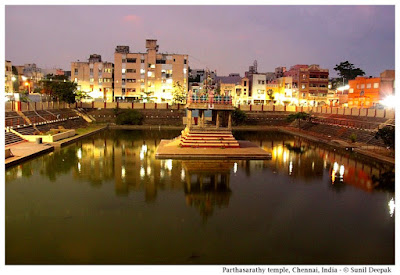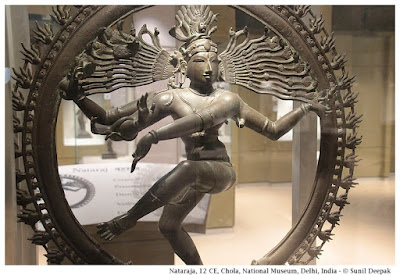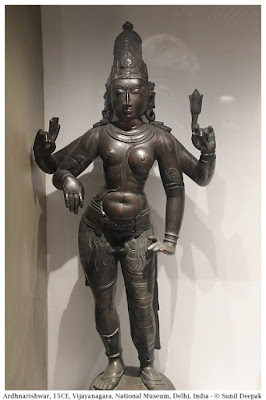During a recent visit to Chennai, a walk along the Marina beach took me to the ancient Parthasarthy temple and to a search for a long-lost childhood friend. This post is about that walk and my search.
My childhood friend
Nani (Narayan), my childhood friend, used to live in a multi-story building inside the area known as NPL, while we were living in Double Storey flats in New Rajendra Nagar in Delhi. His family home was in Chennai, which I had visited a few times.
The last time I had met him was in Delhi, probably around 2001-02, when I had come to India. He had just shifted back to Delhi from Chennai. Since then we had lost contact. Partly it was my fault - I had not looked for him during my visits to India. I had lost his old telephone number and I didn't have his email. I looked for him on facebook but didn't find him. Every now and then I wondered about him.
A memory from the past
Few weeks ago, I was back in Chennai after more than 20 years. One afternoon I was looking at the Google Map when I noticed "Parthasarathy temple" that was not very far from my hotel. The last time I had visited Nani's house in Chennai must have been about 30 years ago, but I was sure that it was right in front of the Parthasarathy temple. I remembered the name of the temple because it was also his father's name.
Parthasarthi temple is the oldest temple of Chennai, built around 8th century CE. Nani's family house in front of it, had also looked very old. Once I had stayed in that house for a few days and remembered its intricately carved wooden doors and a wooden balcony around the central courtyard.
As I remembered my old visit to that house, I decided that I will go to that temple and see if I could find his old house. Perhaps some neighbours will be able to give me news about him, I thought.
The walk at Marina Beach
I took an auto to the Gandhi statue on Marina beach. It was sunset time and the beach was crowded with people.
I started my walk towards the Parthasarathy temple with the help of Google Map on my cellphone. I passed in front of the Vivekanand house, the house where Swami Vivekanand ji had stayed for some time after his return from the US.
I am an admirer of Vivekanand and would have liked to explore that place and its museum but it was becoming dark, so I decided to continue my walk.
A short walk brought me to the Anne Besant street with her statue in a small park at the street corner. Parthasarathy temple was nearby according to the Google Maps.
Reaching the Parthasarathy temple
A small side street brought me to the temple pond. Though I had visited that place and even stayed there right next to that pond, I had no memory of it. I even had difficulty in recognising the temple. The Gopuram of the temple seemed much taller compared to how I remembered it. All the area in front of it, including an long entrance with a row of pillars was surrounded by an iron grill, looked completely different. There were small shops all around and it was full of devotees and visitors.
In my memory it was a quiet street, there was no long covered entrance in front of the temple, there was just an old broken wall. At that time, there were no shops on that street, but just old houses on the two sides. I went all around the temple a couple of times, but could not recognise anything. I tried asking to some older looking shopkeepers, but no one could tell me anything.
After about 15 minutes of looking around, I was almost ready to give up. So I went inside the temple and even inside it seemed different from how I had remembered it. They used to have a rath-yatra with hundreds of devotees filling that street, I remembered.
While coming out of the temple, I had a flash of memory about the address of the old house. It was hiding somewhere there in my head. I checked the numbers on the houses. Number 25, my friend's house, was there but now it was a marriage hall. It looked completely different from the house of my memories.
Outside the marriage hall, I saw a board on the side, with a telephone number. I thought that I will talk to the hall owner and ask him, perhaps he would know about the previous owners of this house. However, my call went unanswered. Dejected, I thought that it was time to go back to my hotel.
Call from the marriage hall owner
I was near the temple pond, looking for an auto, when my telephone rang. It was the hall owner calling me back.
"
When did you buy that house?" I asked him.
"
Who are you? Why do you want to know?" He asked me suspiciously.
So I explained that it was the house of an old friend and that I was looking for him.
"
I have Nani's telephone number, he lives in Delhi", the hall owner told me.
"
Wow!" I had found my friend, I was overjoyed, "
Can you please SMS me his mobile number?"
The man promised to send me the number and then while closing the phone casually mentioned, "
Nani's father still lives in that house, there is a small residential part on the side of the marriage hall, he has a room there."
"
What? Uncle is still alive?" I was flabbergasted. Uncle had retired in the 1980s, so he must be more than 90 years old, probably closer to 100 years.
Meeting Nani's father
The hall owner had explained and this time I had no difficulty in finding the small grilled door on the side, leading to a corridor and to a few rooms. My heart thumping with excitement, I went to uncle's room. His door was open and he was sitting near the TV, busy watching it. I knocked on the door, went inside and touched his feet. "
Uncle, you remember me? I am Sunil, Nani's friend."
He looked at me and smiled, "
Yes, I remember you. Come sit here."
He remembered me! Suddenly I was laughing and crying at the same time, feeling like a child once again.
We talked about old times. Nani has a son and a daughter. I had seen his son Ravi as a baby, but I had never seen his daughter. My friend's elder brother, Cheenu, was no more, he had died six years ago. Cheenu's wife and daughter now live in Hyderabad.
Uncle called Nani on his mobile and we spoke. He lives in NOIDA. When I go back to Delhi, I am going to see him.
Finally
Some times crazy ideas lead to good things. I am so glad that on that day when I saw Parthasarathi temple on the Google Map, I decided to go and search for my friend's old house.
***









































